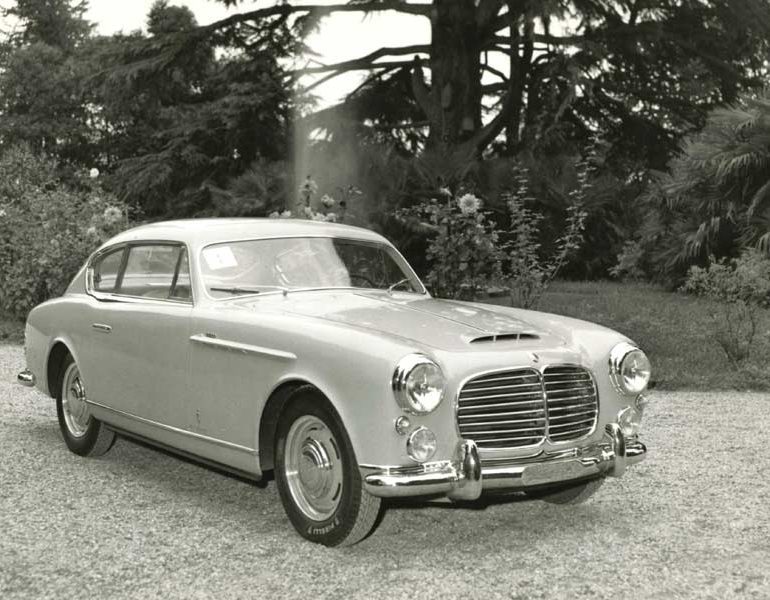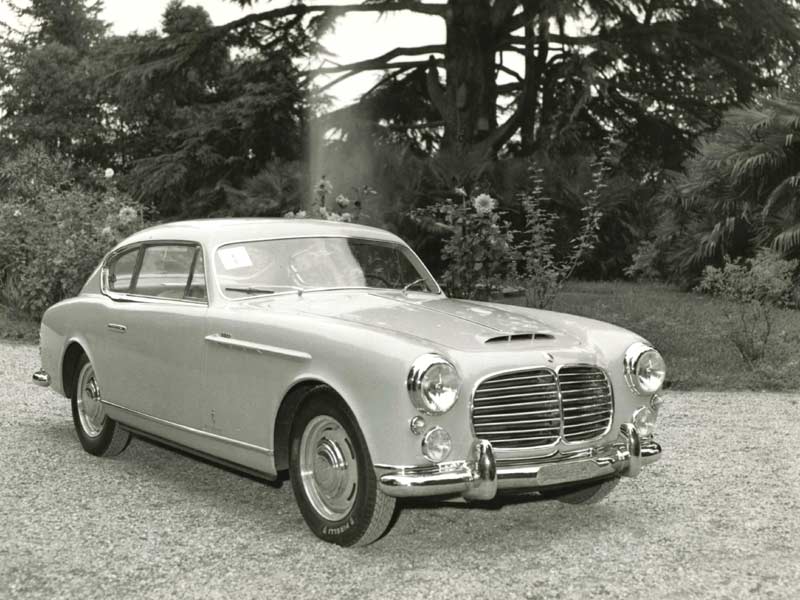1950→1953 Maserati A6G 2000
In the name A6G 2000, the “A” stood for Alfieri in honour of founder Alfieri Maserati who passed away in 1932, “6” indicated the number of cylinders and “G” stood for Ghisa, acknowledging the cast-iron technique used to construct the engine blocks – however, Maserati soon reverted to alloy castings. The 2000 figure denoted the displacement expressed in cubic centimetres, ie. 2 litres. Both bore and stroke had been increased from the previous 1.5 litre model. The straight-six featured a chain-driven overhead camshaft, with a three-carburettor set-up allowing the engine to produce between 90 and 100 hp and gave a top speed of between 160 and 180 kph (100 to 113 mph), depending on engine developments. Chassis dimensions remained unchanged, but the rear suspension was updated with cart-springs derived from those featured on the Fiat 1100.
The Maserati A6G 2000 was unveiled at the 1950 Turin motor show with Pininfarina coachwork. Pininfarina built nine four-seater fastback coupes, all characterised by a high waistline. Frua of Turin supplied five convertibles plus a single coupé, whilst Vignale also added a one-off coupé penned by Giovanni Michelotti. All 16 cars in the short production run were assembled between 1950 and 1951, although the model was only replaced in Maserati’s line-up in 1954 with the introduction of the heavily revised A6G/54. Hand-built and highly exclusive, the A6G series firmly established Maserati as one of the finest manufacturers of sports cars in the world thanks to the model’s quality, refinement and performance.
In Detail
| submitted by | Richard Owen |
| type | Series Production Car |
| production years | 1950 – 1953 |
| released at | 1950 Turin Motor Show |
| built at | Modena, Italy |
| production | 16 |
| engine | Inline-6 |
| position | Front, Longitudinal |
| aspiration | Natural |
| ignition | Marelli ST95DAS Coil |
| valvetrain | Chain Drive DOHC, 2 Valves per Cyl |
| fuel feed | 3 Weber 36 DO2 Carburetors |
| displacement | 1954 cc / 119.2 in³ |
| bore | 72 mm / 2.83 in |
| stroke | 80 mm / 3.15 in |
| compression | 7.8:1 |
| power | 74.6 kw / 100.0 bhp @ 5500 rpm |
| specific output | 51.18 bhp per litre |
| bhp/weight | 88.97 bhp per tonne |
| body / frame | Body over Tubular Steel Chassis |
| driven wheels | RWD |
| wheel type | Spoked Wire or Steel Disc |
| front tires | 5.50×16 |
| rear tires | 5.50×16 |
| front brakes | Hydraulic Drums |
| front wheels | F 40.6 x 8.9 cm / 16.0 x 3.5 in |
| rear wheels | R 40.6 x 14.0 cm / 16.0 x 5.5 in |
| steering | Worm & Sector |
| f suspension | Indepedent w/Coil Springs, Houdaille Dampers |
| r suspension | Live Axle w/Coil Springs, Houdaille Dampers |
| curb weight | 1124 kg / 2475 lbs |
| wheelbase | 2550 mm / 100.4 in |
| front track | 1274 mm / 50.2 in |
| rear track | 1252 mm / 49.3 in |
| length | 4080 mm / 160.6 in |
| width | 1520 mm / 59.8 in |
| height | 1350 mm / 53.1 in |
| transmission | 4-Speed Manual |
| gear ratios | 3.68:1, 1.78:1, 1.35:1, 1.00:1 |
| top speed | ~159.3 kph / 99.0 mph |
| fuel capacity | 55 litres or 14.52 gal. |





